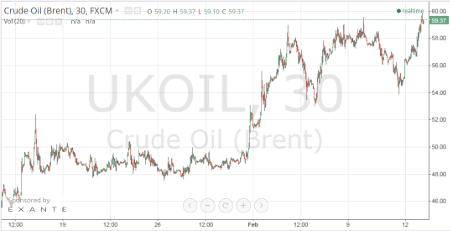Oil's collapse is almost over: What now?
13th February 2015 10:03
by Lee Wild from interactive investor
Share on
Brent crude plunged 60% between mid-2014 and late January, ending up close to $45. For West Texas Intermediate (WTI) it was lower. Falls of this magnitude are typically associated with recessions or supply surges greater even than today's Saudi-inspired glut. But global oil production has hit a 10-year high, US output a 30-year top and OPEC has introduced the most aggressive price cuts in the cartel's history. There's talk that the worst is over, but is it? And, if it is, what are the implications for the global economy and equity markets?
Well, we've talked about this recently when the analysts at Citi said WTI could tumble back toward $20 a barrel. The team at rival JP Morgan is not quite so bearish, yet still believes a significant build in oil inventories could nudge Brent to a low of $38 next month.
"We view the $10/bbl rally since late-January as being a position driven event and one that will be reversed in the coming weeks," writes the broker. And there are plenty of others still betting on another slump. Indeed, non-commercial short positions in WTI futures are at their highest level since September 2010, "indicating that speculative open interest is positioned for further price declines."

Source: TradingView
"It is premature to translate the recent collapse in the oil rig count into a immediate reduction in output, a tightening in market balances and therefore a bottom in prices," says JPM. "We have indeed been forecasting that prices would trough this spring as non-OPEC producers - particularly US shale - reduced capex and output in response to lower prices."
But it thinks the bottom will likely come in March/April, with average Brent prices of around $42 a barrel in the first quarter and $43 in the three months to June. After that, expect a shallow recovery to average levels at $53 in the third quarter and $58 in Q4. "Call it a u-shaped profile, in lowercase, since prices would remain near their lowest level in a decade and substantially below the $100 average of the past five years."
So, how will this affect global growth?
About two-thirds of the slump in global commodity prices reflects an increase in non-OPEC production and the cartel’s reluctance to reduce output. JP Morgan estimates that the collapse in oil prices adds 0.6 percentage points to global GDP in 2015.
Of course, an oil-driven increase in consumption and, therefore, GDP should grow company earnings. According to JP Morgan economists a 10% fall in the oil price sustained for an entire year would increase global real GDP growth by 0.14%. A 50% fall is worth 0.7%.
That's good news for risky assets like equities and credit spreads and negative for bond duration, explains the broker, "as the impact on inflation should be largely a transitory effect on headline rather than core prices."
True, greater capex cuts could force a "severe" rethink on revenue assumptions, so watch out for further negative earnings revisions to dampen sentiment toward the oilfield services industry. But because JPM reckons central banks will win the war on deflation its equity portfolio is tilted towards growth, via an overweight of global cyclicals and specifically, consumer discretionary.
Potential for trouble
However, there's a problem, and it could spell bad news for dividend yields. "In our view, a continued degradation to legacy asset returns, measurable ROACE (Return on average capital employed) well below WACC (weighted average cost of capital) combined with less valuable reserves must ultimately raise a question mark on the sustainability of certain aggressive dividend commitments," warns JPM.
"Proven developed reserves essentially pay most of Big Oil's dividend. We expect the market's focus on dividend sustainability to shift from near term balance sheet headroom to medium term ROACE spread over WACC. As this shift occurs, we expect dividend yield escalation to inhibit sector and share price performance and therefore remain relatively cautious on higher yielding, big dividend names - they could be a value trap."
However, any threat to payouts at the big UK oil companies looks remote right now. dividend is regarded as sacrosanct; it hasn't cut the dividend since World War II and total dividends have shown compound growth of 5% since 1989. , rightly or wrongly, has resumed dividend payments, too. They're both among the best yielders in the FTSE 100 and will likely remain so.
This article is for information and discussion purposes only and does not form a recommendation to invest or otherwise. The value of an investment may fall. The investments referred to in this article may not be suitable for all investors, and if in doubt, an investor should seek advice from a qualified investment adviser.